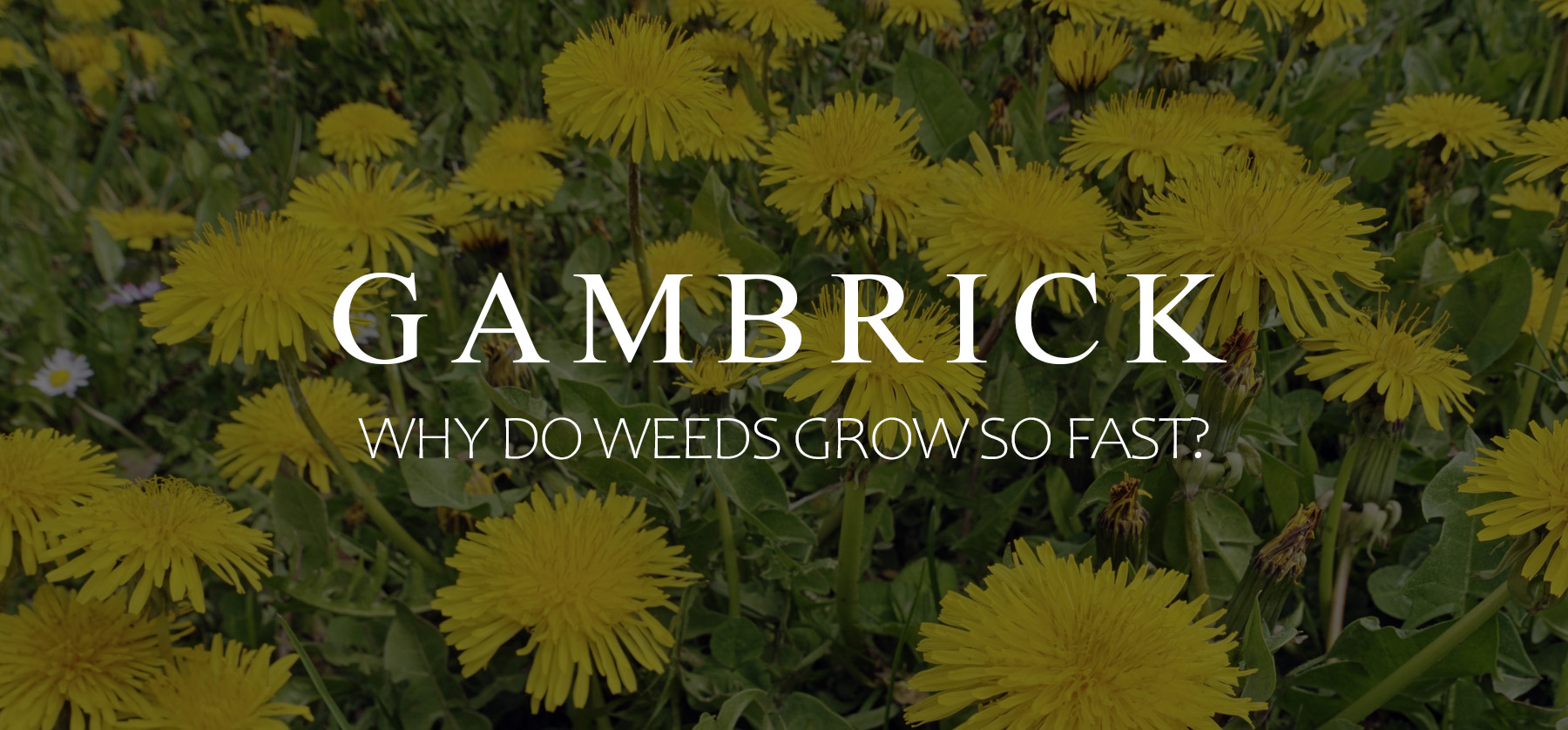Why Do Weeds Grow So Fast?
The primary reason weeds grow so fast is their genetics. They reproduce and grow at a very fast rate because they’re typically small simple plants with shallow roots. Weeds absorb water at the top of the soil which steals it from plants that have deeper root systems. They also flower easily and spread seeds to a wide area without the need for planting. Weeds can quickly spread and take over an entire yard, field or garden, choking out other more desirable plants. In addition, weeds can grow from existing roots that are already in the soil waiting for Spring. This gives them an advantage over other plants that grow from a seed.
Weeds spread and outgrow surrounding plants by adapting to a wide range of environmental conditions. They have a very efficient seed-dispersing design which allows them to easily spread seeds and reproduce over a wide area.
Weeds grow faster than desirable garden plants and flowers for the following reasons:
- Most weeds have a very simple design and don’t produce fruits, vegetables or large flowers which helps them mature faster.
- Weeds can sprout from existing root systems or seeds lying dormant in the soil.
- Dormant weeds living in your yard have already acclimated to the soil conditions.
- Weeds are hardy plants that are tough to get rid of. When killed, their roots may survive which brings them back again.
- Some weeds only live about 6–8 weeks. They grow from seed to flowering plant quickly which helps them spread.
- Weeds are usually native plants that grow naturally in the local ecosystem. This gives them an advantage vs other plants which are often non-native and need special care.
All of these factors are why it can sometimes feel like your lawn and garden are overrun by weeds overnight.
What Is A Weed?
A “weed” is simply an unwanted plant that grows naturally. They’re almost always native to the area and grow without any help from humans.
Weed is not a scientific term used to identify a specific plant or family of plants. Many types of plants qualify as weeds. In a lawn or garden, almost any wild plant that was not intentionally planted could be considered a weed.
The word weed is typically used to describe a plant that’s grown in an undesirable location. This could be a garden, lawn, sidewalk, driveway, patio or other unwanted location.
A Dandelion (Leontodon taraxacum) is a common type of wildflower which is generally considered a weed. They sprout bright yellow or white flowers that are actually seeds which can blow in the wind for hundreds of feet. No one actually plants dandelions, but you can find them just about everywhere plants can grow.
Some weeds can be invasive and disrupt local agriculture. They typically have shallow root systems which steal water away from other more desirably plants like vegetables. Controlling weeds is a constant battle for farmers because they steal resources like water, sunlight and nutrients from larger more complex plant life.
Which plants are considered a weed is a matter of opinion. Many agriculturists consider weeds to be more important to the local ecosystem than your lawn, garden or landscaping. However, there are some shared characteristics most weeds have which include:
- They grow in undesirable locations like your sidewalk, garden or driveway
- Weeds grow very quickly without any help from people
- They’re wild plants that grow on their own
- They produce lots of seeds
- Weeds are hardy plants able to live in poor conditions
- Hard to kill
How & Why Do Weeds Grow So Fast?
Weeds are native plants which are perfectly adapted to life in their local environment. This gives them a huge advantage compared to plants like grass, vegetables, flowers, etc. which are usually foreign to the area and have a harder time surviving without constant care and fertilization.
Most plants we intentionally grow are larger, more complex, non-native and mature slowly because they grow large vegetables or flowers. This gives weeds the appearance that they spread and grow very quickly. But in reality we’re just comparing them to much slower growing plants.
This is why it can feel like your lawn and/or garden is overrun by weeds overnight. They sprout quickly and flourish before larger more complex garden plants have a chance to mature.
Weeds don’t need people to care for them, grow in almost any soil, don’t need watering, bug spray or fertilizer. This perfect adaptation to the local environment helps weeds spread and grow much faster than other plants.
In the next section we’ll discuss the traits weeds have that allow them to germinate and grow so quickly?
Weeds Grow So Fast Because They’re Perennials
One of the reasons why weeds grow so fast is because the weed seeds and root systems are already in the soil. They lye dormant underground waiting for the right temperature and moisture conditions to sprout up. When you plant your seeds in Spring, the weeds have a head start because they’re already in the ground and growing. They can usually sprout up before your seeds can even start to open up.
Gardeners often help their vegetables by growing them in pots and transplanting them into the garden. That gives the plants a head start against the weeds. This is an excellent strategy because the plants does no have to compete with the weeds in the early stages of its life.
Some weeds grow from roots that have been alive for many years. These kinds of plants are called perennials. As long as the root survives, the plant will regrow every season. When the season is over, the above ground portion of the plants withers, but the below ground root stays alive and lies dormant.
Lawn grass is a great example of a perennial.
Perennial weeds grow extremely fast and are much harder to kill than annuals, which have to grow from seed every year.
Perennial roots store energy in them from previous years of growth. As soon as temperature conditions are right, the root starts growing and quickly sprouts a weed. This is a much faster process than growing from a seed which is why perennial weeds are very hard to control.
How Fast Weeds Grow
Weeds typically grow at a faster rate than plants we actually try to grow in our lawns and gardens. Below is a chart showing 10 common perennial weeds, how big they grow, their growth rate and the best way to get rid of them.
| NAME | PERENNIAL | SIZE | GROWTH RATE | BEST DEFENSE |
| Yellow Wood Sorrel | Yes |
6-15 Inches Tall | Mature in about 2-3 weeks | Hand Pull With Poison & Mulch |
| Nutsedge | Yes | 6-12 Inches Tall | Very Fast / Mature In Days | Hand Pull Or Poison Plus Aeration |
| Broadleaf Plantain | Yes | 4-15 Inches Tall | 8-15 Weeks After Germination | Hand Pull With Poison |
| Thistle | Yes or Biennial Depending On Species | 4-5 Feet Tall | Fast / 12-15 Wide Patch Per Year | Hand Pull With Herbicides |
| Wild Onion | Yes | About 18 Inches Tall | From Seed To harvest In 50-60 Days | Hand Pull With Herbicides |
| Crab Grass | Yes By Seed Not Root | Up To 2 Feet Tall | Grows Faster Than Most Turfgrass | A Weeder Tool That Removes The Roots |
| Purslane | Yes By Seed Not Root | 4-8 Inches Tall | 6-8 Weeks | Hand Pull With Herbicides |
| Lambsquarters | Yes By Seed | 3-4 Feet Tall | 5-6 Weeks | Hand Pull With Herbicides Containing Dicamba |
| Pigweed | Yes By Seed | 2-3 Feet Tall | Up To 2 Inches Per Day | Hand Pull With Herbicides |
| Dandelion | Yes | Up To 2 Feet Tall | 9-12 Days | Hand Pull With Herbicides |
Weeds Grow So Fast Because They’re Small & Simple
Many weeds grow so fast because they’re small and simple plants that don’t require as many resources. They can reach maturity quickly, reproduce easily and are adapted to live in harsh environments without and aide from humans.
When we compare the speed at which crabgrass grows vs a tomato plant, it’s not even close. Crabgrass is a small weed that’s fully grown in about a week. Tomatoes are a much larger and more complex plant. They not only have to reach maturity themselves but also produce complex fruits that need time and resources to mature.
When we plant a garden or do landscaping, the plants we’re trying to grow are usually very complex, large and take time to mature. They often grow large flowers, fruits and vegetables. Comparing a complex plant to a more simple weed is an unfair comparison.
Small and simple plants will always grow faster that larger more complex plants. And they require a lot less resources like food, water, space and time to do it.
Weeds Grow So Fast Because They’re Native
Most people consider weeds to be an invasive species that takes root and overpowers their lawns or gardens. However just the opposite is true. Weeds are native to the area and belong in the local ecosystem. It’s the plants we’re trying to grow that generally don’t belong.
Weeds are well adapted to the local environment, water levels and soil conditions. They don’t require planting, fertilizer, sprays or water to thrive. The reason why is because they’re native, natural, wild and belong in the environment. But most of the grasses, plants and vegetables we try to grow don’t.
When a non-native and native plant compete, the native plant has an advantage because they’re adapted to the environment and don;t need additional resources to grow. However, when those resources are present they grow even faster.
Essentially, when we plow, fertilize and water than land trying to grow crops, grasses, flowers or landscaping plants, we’re also helping the weeds.
Fertilizers in particular are like steroids to a weed because they’re not used to getting that much wood from the local environment.
Because weeds are native plants, they get an advantage vs non-native plants when we fertilize and water the land. This makes them grow even faster that they normally would.
What Causes Weeds To Grow?
Like all plants, weeds need air, sunlight, water, nutrients and space to grow. But because weeds are wild and adapted to local conditions, they generally require less resources than non-native plants. This makes them more competitive and often dominant compared to plants we intentionally grow like vegetables, grasses or flowers.
Seeds and weed roots often lay dormant beneath the soil waiting for Spring. They typically grow faster than more complex plants, so as soon as temperatures rise they sprout up. This is why we often see weeds start growing before other plants each new season.
Every gardener knows the first plant to start growing each season is usually the weeds. If they’re not dealt with immediately they can quickly spread and overpower a garden.
Cultivated plants usually start growing after the weeds. This leads to your more desirable plants struggling to sprout because weeds are absorbing nutrients and water.
Even though weeds are wild and do not need out help to spread and grow. They get a lot of it. When we plow, fertilize, spray and water land to grow plants, we also make it easier for the weeds. They’re the same as any other plant and have the same requirements to live and grow.
Remember, when you cultivate land to grow vegetables or flowers, you also make it easier for the weeds to thrive.
How Do Weeds Grow Without Water?
Weeds are wild plants that are native to the area and highly adapted to the local climate and soil conditions. Because of this, weeds thrive even in harsh environments with limited water.
Weeds do not actually grow without water, they just appear to because we compare them to plants we grow ourselves. Generally speaking, most of the plants we try to grow are not natural or native to the area. This means they’re not adapted to local conditions and need special care. Usually that care is more water than what is readily available in nature.
Most gardens, trees, bushes, grasses and flowers need constant watering. This is because they’re not typically native plants to the area. We have to supply water to fulfill their needs or they’ll die. But weeds don’t need additional water because they’re adapted to live on whatever amount of water is normal for the area. This gives the appearance that they live without water.
Weeds thrive without extra water because they’re adapted to the local environment. The plants, trees, grasses, bushes, flowers, etc. that grow wild in your region don’t need any help from humans to live. They’re able to deal with the local climate, soil conditions and water supply.
How Do Weeds Spread
Weeds are a natural plant that spread and grow in nature without the help of humans. Unlike the plants we intentionally grow, they don’t need to be planted, watered fertilized or sprayed. Weeds have mechanisms that take advantage of their environment to easily spread their seeds at great distances.
A few of the ways weeds spread include:
- Design: Weeds produce seeds in a variety of designs that can spread through the air, in water or from activities as simple as walking by.
- Air: Many weeds, like dandelions, have seeds that are lighter than air and can fly hundreds of feet every time when the wind blows.
- Animals: Some weeds produce stickers that cling onto animals and people that pass by. When the seeds fall off they work themselves into the soil and grow.
- Water: When it rains, ground water can pick up seeds and move them for hundreds of feet. When they settle into their new location they can take root and grow.
- Humans: People can pick up weeds that produce stickers and carry them around for great distances. They also make life easier for weeds by cultivating, watering, mowing, fertilizing and plowing the land.
Design
There are thousands of species of weeds growing all over the world. Each has a lightly different way of spreading their seeds and reproducing. Some weeds contain sharp spikes that stick onto people and animals as they walk by. And other produce extremely light seeds that are carried by the wind.
For example, the Dandelion produces tiny seeds that are lighter than air. When the wind blows, seeds are released from the plant and carried for hundreds of feet. Many people also believe that blowing a Dandelion while making a wish will make the wish come true. In either case, their seeds are spread throughout the area.
Some seeds are spread by water, some by air and others by animals or people.
There are even weeds that spread seeds inside the fecal matter of animals that eat them. Animals eat the weeds but can not digest their seeds. When they eventually poop, the seeds are both fertilized and replanted in a new location.
Weeds are wild plants that do not need planting or cultivation. So they all have a unique design that allows them to spread their seeds and multiply.
Air
The seeds produced by most flowering weeds are light and travel through the air. This makes them extremely hard to prevent.
For example, the Dandelion looks like a white puffball with lots of tiny petals. Those petals are actually dozens of seeds light enough to float in the air. When the wind blows, seeds can potentially travel hundreds of feet away and grow a new Dandelion. This is one of the reasons why weeds with light airborne seeds are so hard to keep off your property.
Weeds with larger seeds that fall to the ground are easier to contain because it’s harder for them to travel long distances. These types of weeds rely on things like animals, people or water to distribute their seeds to other areas.
Animals
Many types of weeds rely on animals to spread their seeds to different locations. Some have seeds with spikes that can attach to an animal’s fur as it brushes against the weed. By the time the seed falls off it could be miles away.
Another way animals help spread weeds is by eating them. Many weeds produce seeds that can’t be digested. When an animal eats and later passes the seed, it takes root in a location far away from the parent plant.
Some seeds can even be eaten and passed intact by birds. This can potentially spread the seed many miles away.
Water
Many types of weeds produce seeds that fall to the ground. When it rains, the seeds are picked up and carried away by the flow of water. Making it into a stream or river means they can potential find new fertile ground miles away.
When the seed eventually settles on new dirt, it can sprout a fresh weed and the cycle continues.
Weeds that spread their seeds by water are very common in wetlands and marches where water is prevalent.
Humans
Like animals, people that walk by a spiked seed can potentially relocate it miles away. This is very common amongst hikers. If you’ve ever walked a mountain trail you’ll know how easy it is to pickup bunches of spiked seeds on your pants, shoes and socks.
Humans also help weeds spread by cultivating the land. Even though weeds don’t need out help to spread and grow, we give them plenty of it. When people plow, fertilize, water, spray and mow the land, we make it easier for not only our plants to grow, but also the weeds.
Many weeds have even spread far distance because of plane or ship travel. Plants have even ended up on entirely different continents by hitching a ride on an overseas delivery of fruits and vegetables or other cargo.
People Help Weeds Reproduce More Quickly
Weeds spread and grow extremely fast compared to other plants largely because of their genetics and how hardy they are. They’re wild plants that germinate and spread their seeds naturally without any help from humans. They don’t require planting, watering, fertilized or sprays to thrive. In fact most weeds grow best when completely left alone.
Even though weeds don’t need our help in order to spread and grow. They get lots of it when we plow, fertilize, water and spray the land.
- Weeds are adapted to live in harsh wild conditions, so they have no problem living in our fertilized and watered lawns and gardens.
- Almost all weeds are native plants which live on their own in the wild.
Human farming and landscaping practices have actually contributed to the speed at which weeds can grow.
Weeds are adapted to living life in harsh conditions. But humans plow and clear land, fertilize, irrigate, mow, burn and kill pests. All of these things improve conditions making it easier for weeds to spread. We make poisons to kill different types of weeds. But because weeds are so used to surviving in harsh conditions, they can develop a tolerance for many types of poisons.
Remember, weeds are basically the same as any other plant. The only thing that makes them weeds is that people do not want them around. The term weed is not a scientific classification, it’s a nickname people came up with to describe a wide range of local plants they don’t like.
When we make conditions better for plants we want, like vegetables, trees, bushes and flowers, we also make them better for the weeds.
Fast Growing Dominant Weeds
Some weeds grow so quickly because they have a very short growth cycle between germination and flowering. This means they can sprout up and produce seeds soon after flowering. In some cases this can take just a matter of weeks.
Many weeds can sprout up, mature, flower and produce seeds before larger more complex plants can even begin to grow.
- Weeds grow from seed to adult plants quickly because they have a high photosynthetic rate. They also possess high light saturation intensity and a lower carbon dioxide compensation point. This means they’re able to utilize prolonged and intense levels of sunlight which convert into plant energy even in the presence of low carbon dioxide levels.
- Some weeds develop extensive root systems which are hard to kill. Even when you pluck or poison a root, if any survives underground the weed can sprout up again. Weeds like dandelions have thick, deep roots that are hard to completely pluck up. Once they start growing it’s very hard to get rid of them.
- Most weeds can survive in sub-optimal soil conditions because they’re generally small, simple and don’t grow fruits, large flowers or vegetables. They don’t need the same amount of water and nutrients as larger more complex plants.
- Because no one cultivates, fertilizes or waters weeds, they’re able to survive in a wide range of climate and soil conditions.
Because of all these factors, weeds are generally tougher and require a lot less care than plants we intentionally cultivate like vegetables, large flowers, grass and bushes.
Many weeds grow so well they can become dominant, killing off other plants when not kept under control. They can quickly spread, absorbing so much water, sunlight and nutrients that other plants simply can’t survive in their presence. These can be considered dominant, aggressive weeds.
How Fast Can Weeds Grow?
Some weeds can grow 1–3 inches in as little as 24 hours. An inch or two of growth may not sound like much, but it can quickly overrun a garden in days. Once weeds sprout up, they grow and spread quickly which takes resources away from the plants you’re actually trying to grow.
Many weeds also have short life cycles which is why they spread and grow so quickly.
For example, chickweed completes its entire life cycle from germination to flowering, seeding and dying in just 5-6 weeks.When you see weeds like this sprout up, you have to deal with them quickly or they could quickly overrun an entire garden.
Because weeds grow and reproduce so quickly, it’s important to take measures to control weeds as soon as you see them sprout up. We actually make this worse by fertilizing and watering an area which also provides nutrients to the weeds.
The best way to handle weeds is to kill them as soon as they start growing. Don’t give them any time to grow because they’re taking resources away from the other plants and will reproduce quickly.
Can Weeds Grow Overnight?
Yes, many weeds can grow several inches overnight.This is especially true in areas that have been watered and fertilized, like a garden. The fact is, while we do not want weeds growing in our gardens, we actually make life easier for them.
Weeds are just like any other plant. They require air, nutrients, water and space to grow. When we plow, fertilize and spray an area to grow grass, vegetables or other plants, we also create an ideal environment for the weeds.
Weeds are native plants that are adapted to live in local environments without help from humans. However, when we provide them help, by cultivating and fertilizing an area, they grow even faster.
Fertilizer and water are like steroids to a weed. This is why weeds can often grow overnight once they start sprouting up in your garden.
Why Do Weeds Grow Faster Than Grass?
Weeds grow faster than most grasses because of their genetics. Many weeds have a short life cycle which completes in around 6-8 weeks. This means they sprout up, grow to maturity and reproduce faster than other species like grass because they won’t be around for very long.
Other types of weeds grow faster than grass because they already have dormant root systems in the ground. As soon as temperatures start to rise, these dormant roots start growing and sprout up before the grass can even start to grow. Energy is stored inside the root through Winter so they can start growing as soon as the weather warms up a bit.
Weeds are generally native plants that are well adapted to the local environment. But most grasses are not. This gives weeds an advantage.
Most weeds are tougher plants than grasses and require little to no water. This helps them grow faster than grass which generally requires lots of water to live.
- Some weeds grow faster than grasses because they have established dormant root systems.
- Weeds are native plants that are highly adapted to their local region.
- Weeds can grow 1–3 inches in a day, given the right conditions.
- We help weeds grow faster by watering and fertilizing the area.
All or some of these factors help explain why some weeds grow a lot faster than grass.
Weeds start growing sooner, thrive in the local climate, require less water and generally grow at a faster rate.
Since weeds have the same requirements of food and water as the grass, fertilizing and watering the grass won’t help it keep up with the weeds. You’ll only feed the weeds more and make them grow faster too.
To control weeds you simply have to kill them. There’s no other way to get rid of them because they’re native plants to the area and you’re grass is usually not.
Summary: Why Do Weeds Grow So Fast?
The primary reason weeds grow so fast is their genetics. They reproduce and grow at a very fast rate because they’re typically small simple plants with shallow roots. Weeds absorb water at the top of the soil which steals it from plants that have deeper root systems. They also flower easily and spread seeds to a wide area without the need for planting. Weeds can quickly spread and take over an entire yard, field or garden, choking out other more desirable plants. In addition, weeds can grow from existing roots that are already in the soil waiting for Spring. This gives them an advantage over other plants that grow from a seed.
Weeds spread and outgrow surrounding plants by adapting to a wide range of environmental conditions. They have a very efficient seed-dispersing design which allows them to easily spread seeds and reproduce over a wide area.
Weeds grow faster than desirable garden plants and flowers for the following reasons:
- Most weeds have a very simple design and don’t produce fruits, vegetables or large flowers which helps them mature faster.
- Weeds can sprout from existing root systems or seeds lying dormant in the soil.
- Dormant weeds living in your yard have already acclimated to the soil conditions.
- Weeds are hardy plants that are tough to get rid of. When killed, their roots may survive which brings them back again.
- Some weeds only live about 6–8 weeks. Growing quickly helps them spread.
- Weeds are usually native plants that grow naturally in the local ecosystem. This gives them an advantage vs other plants which are often non-native and need special care.
All of these factors are why it can sometimes feel like your lawn and garden are overrun by weeds overnight.
If you have any questions about weeds, email any time.





















